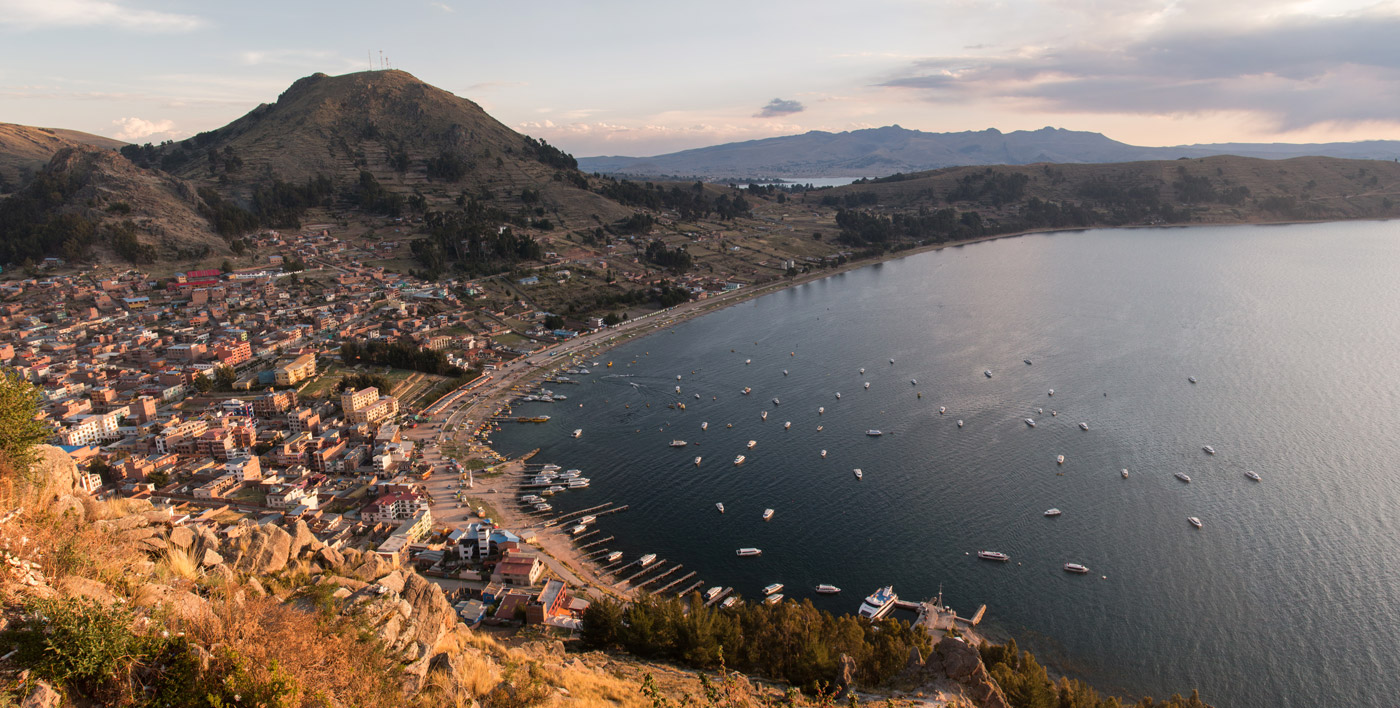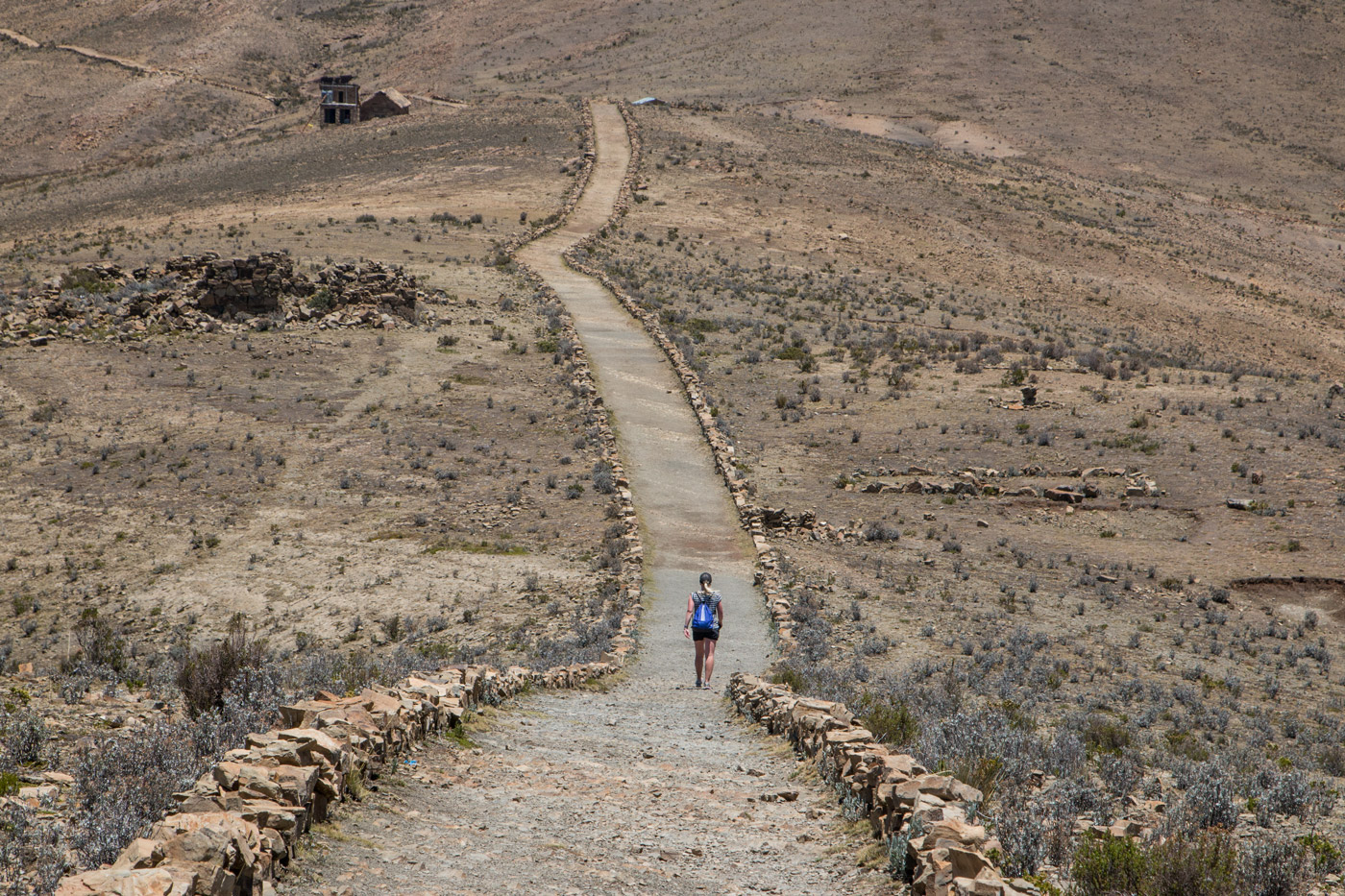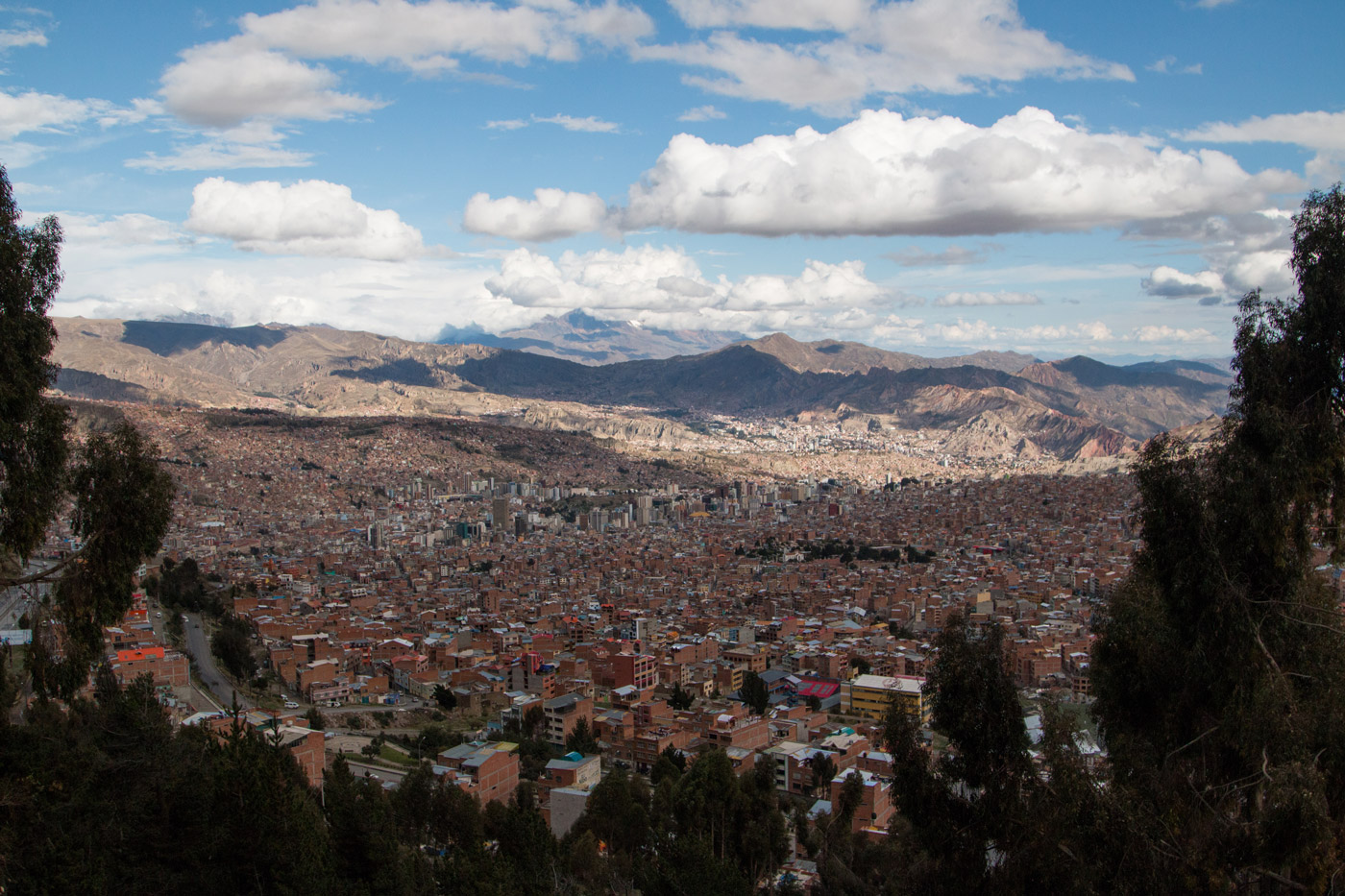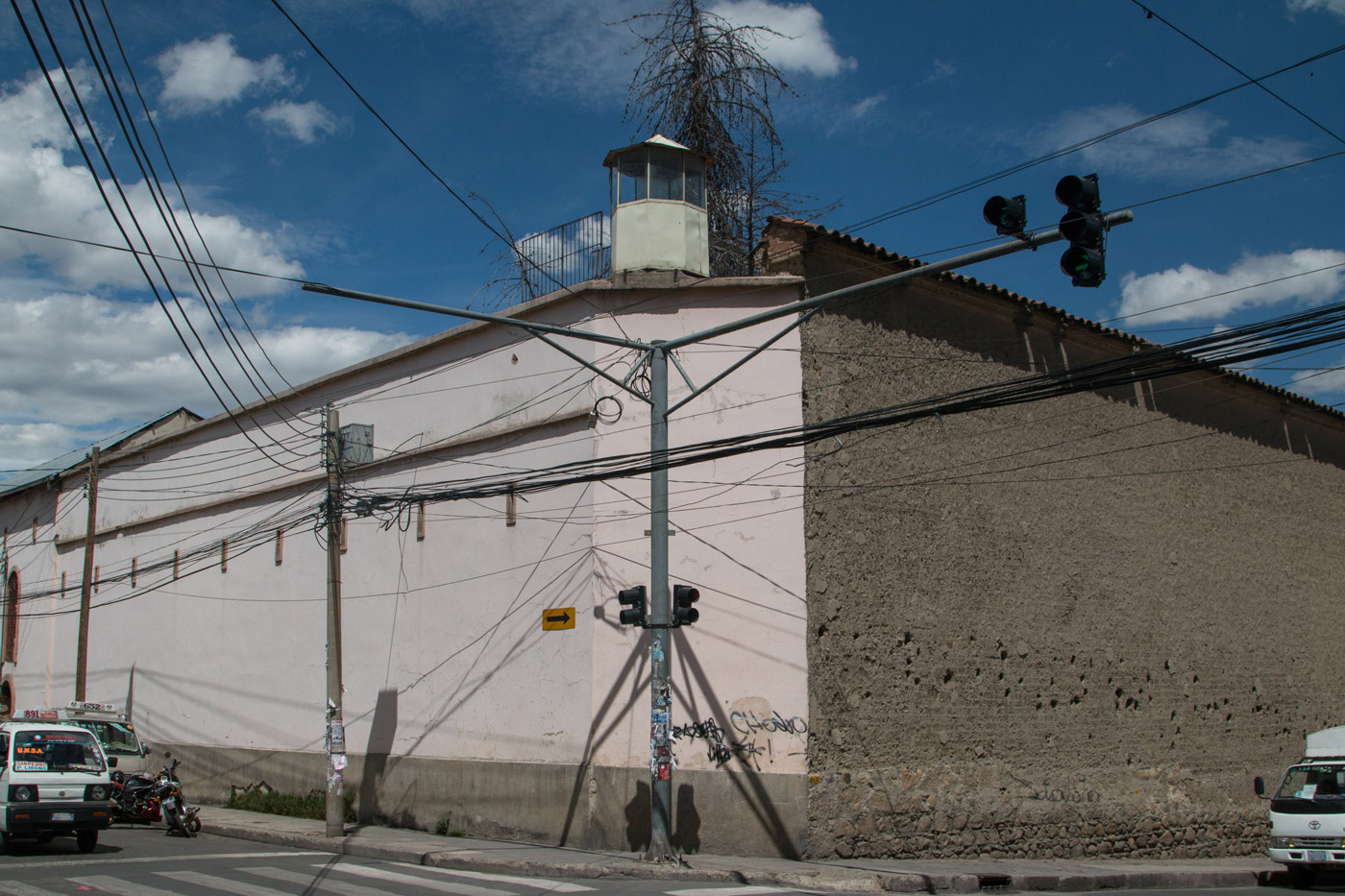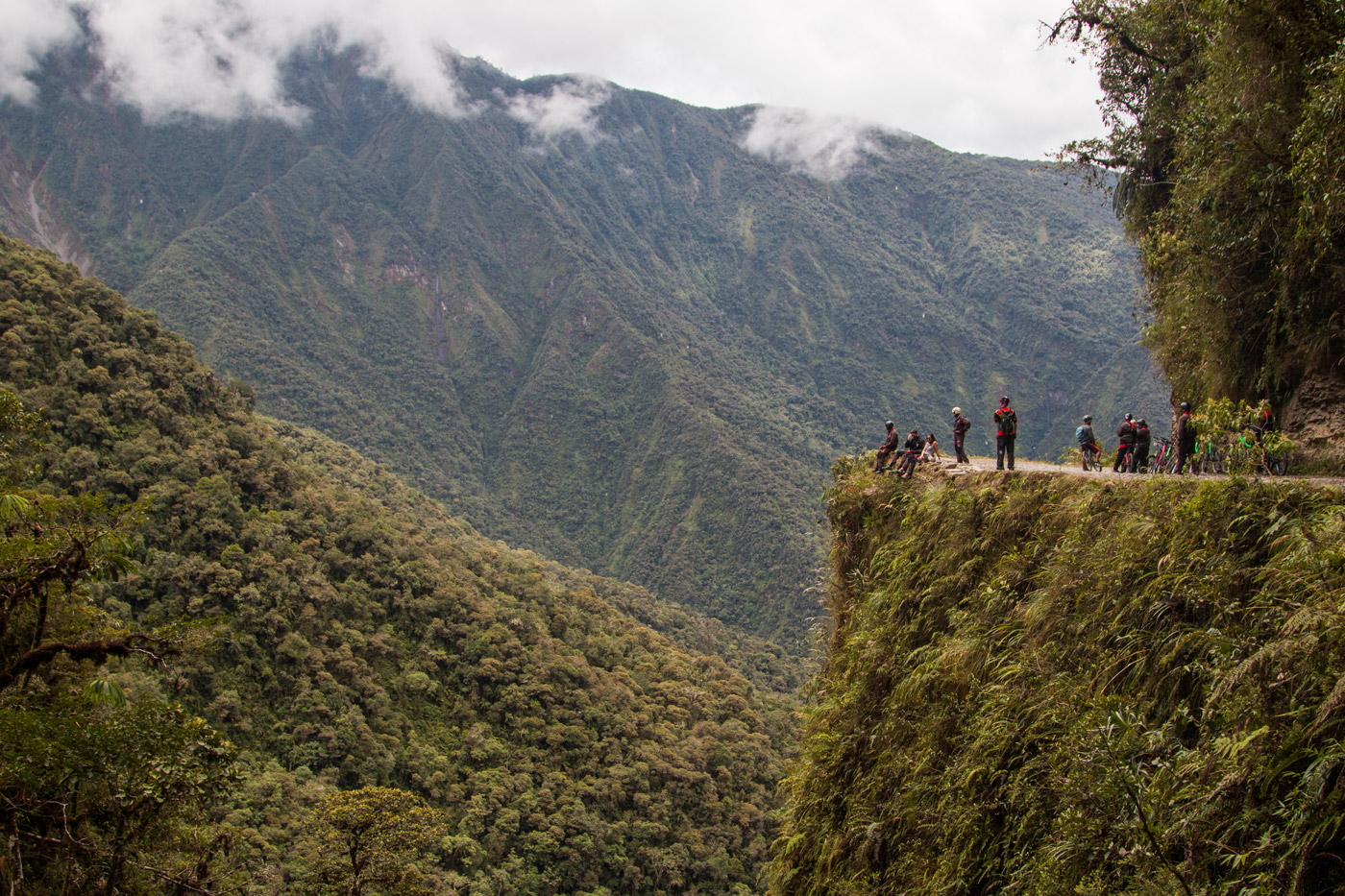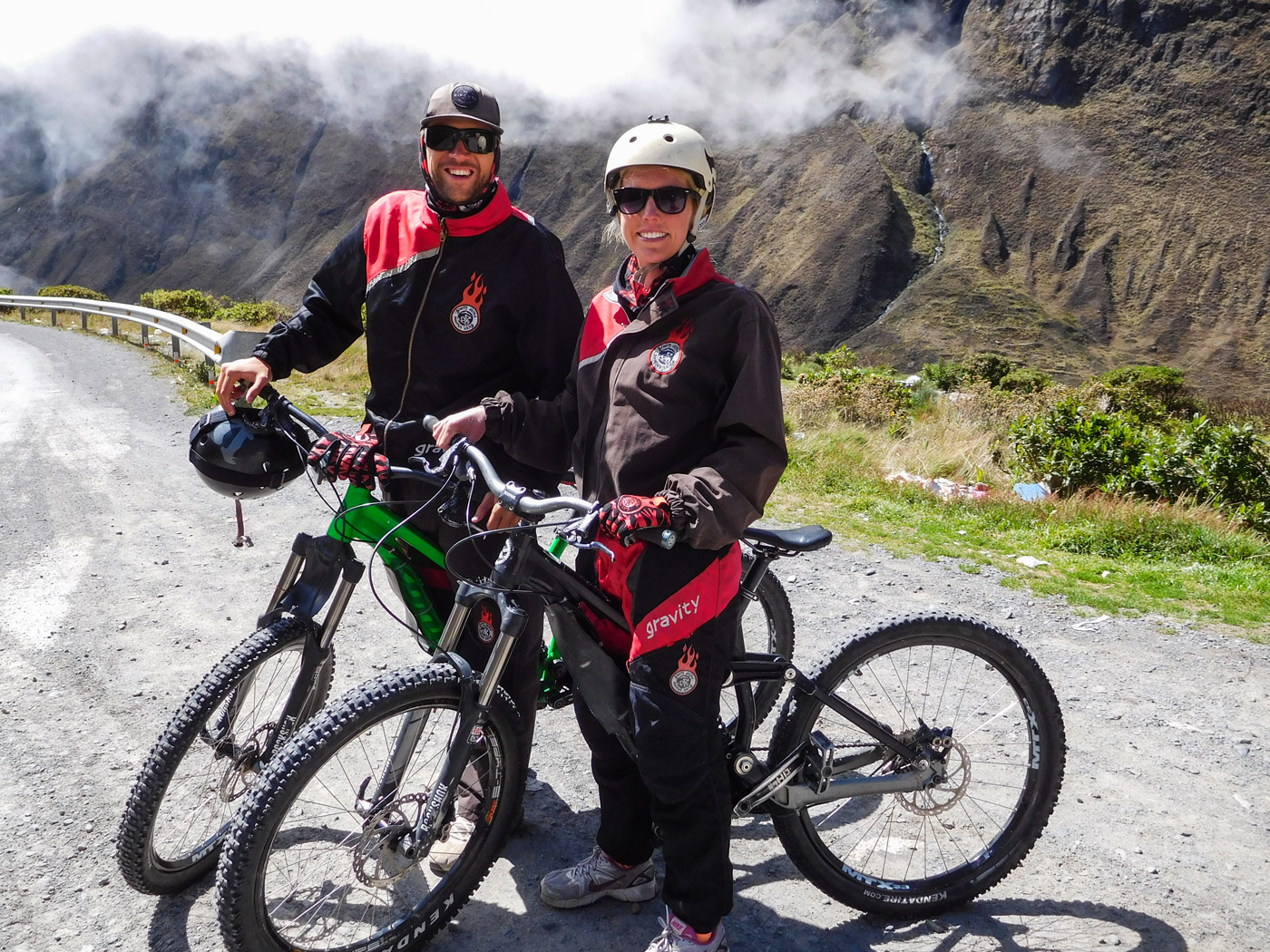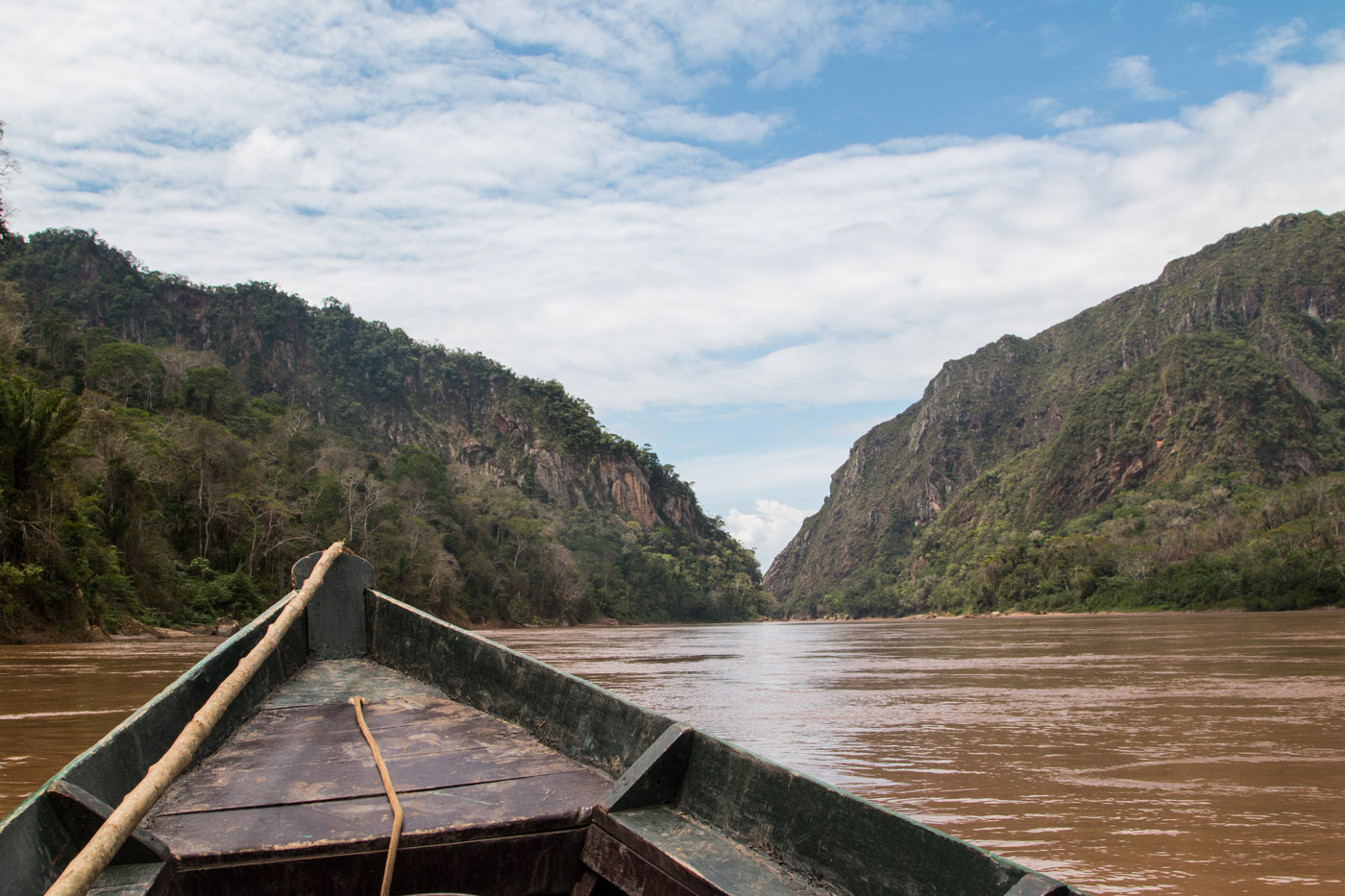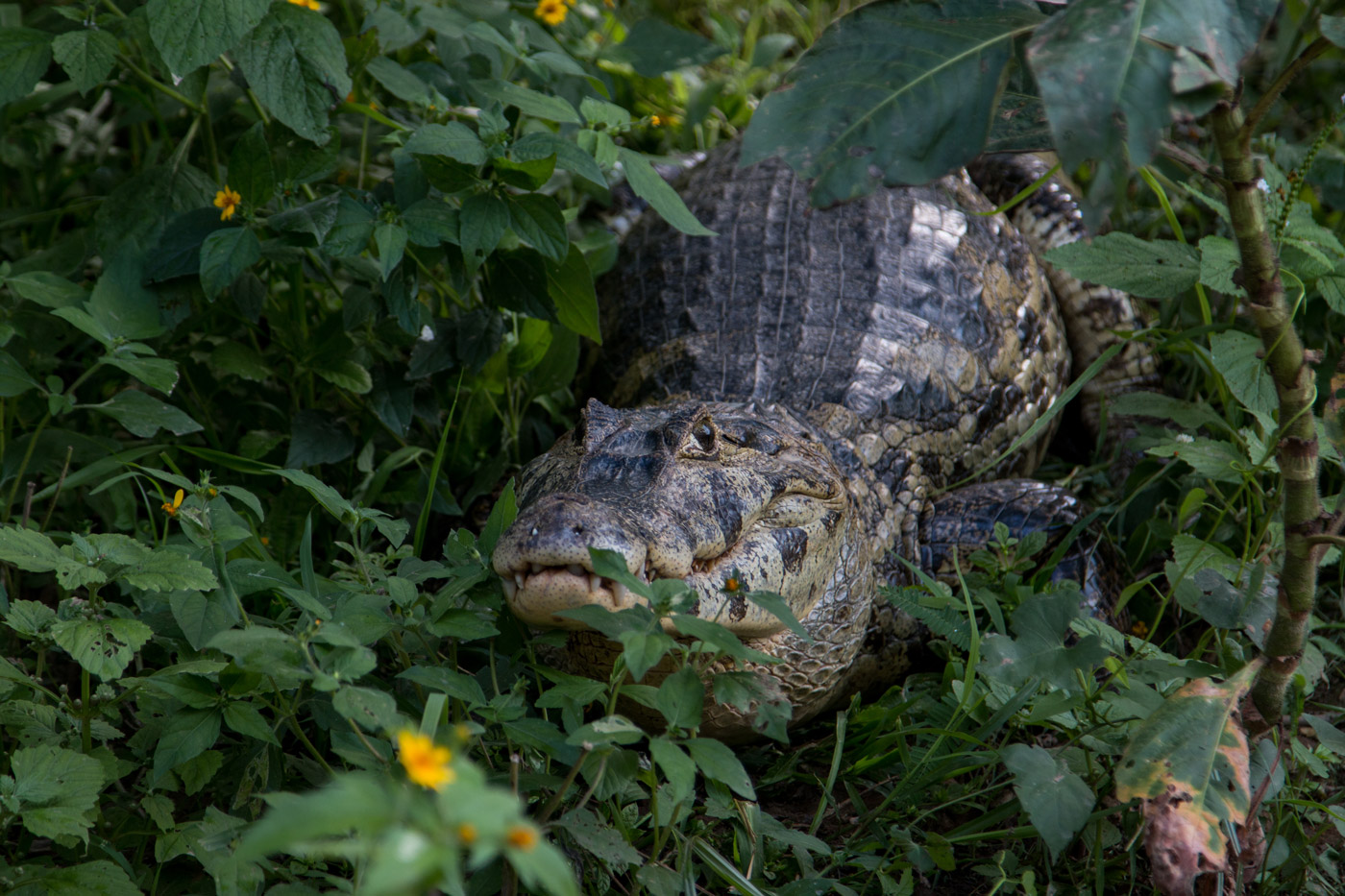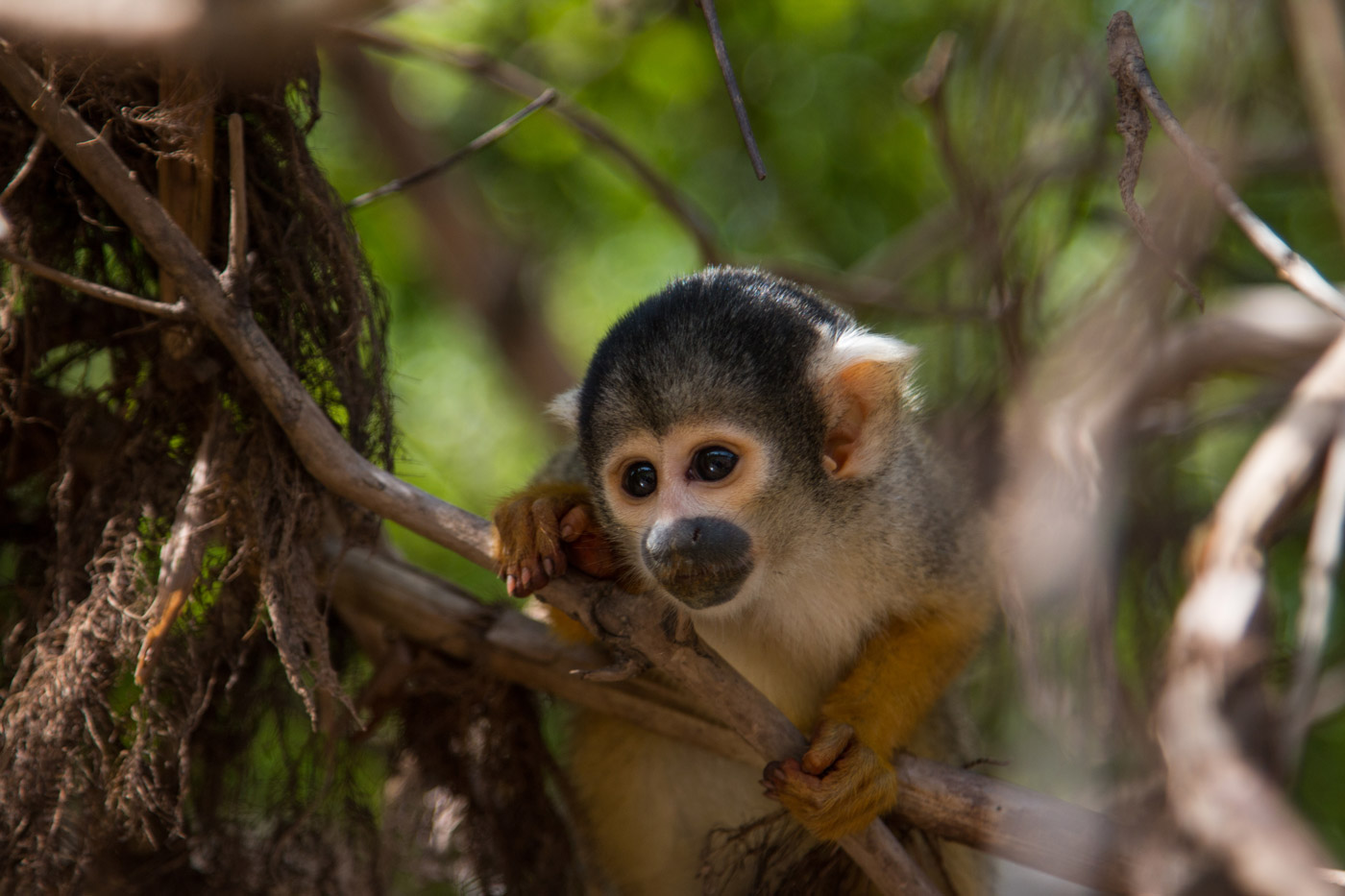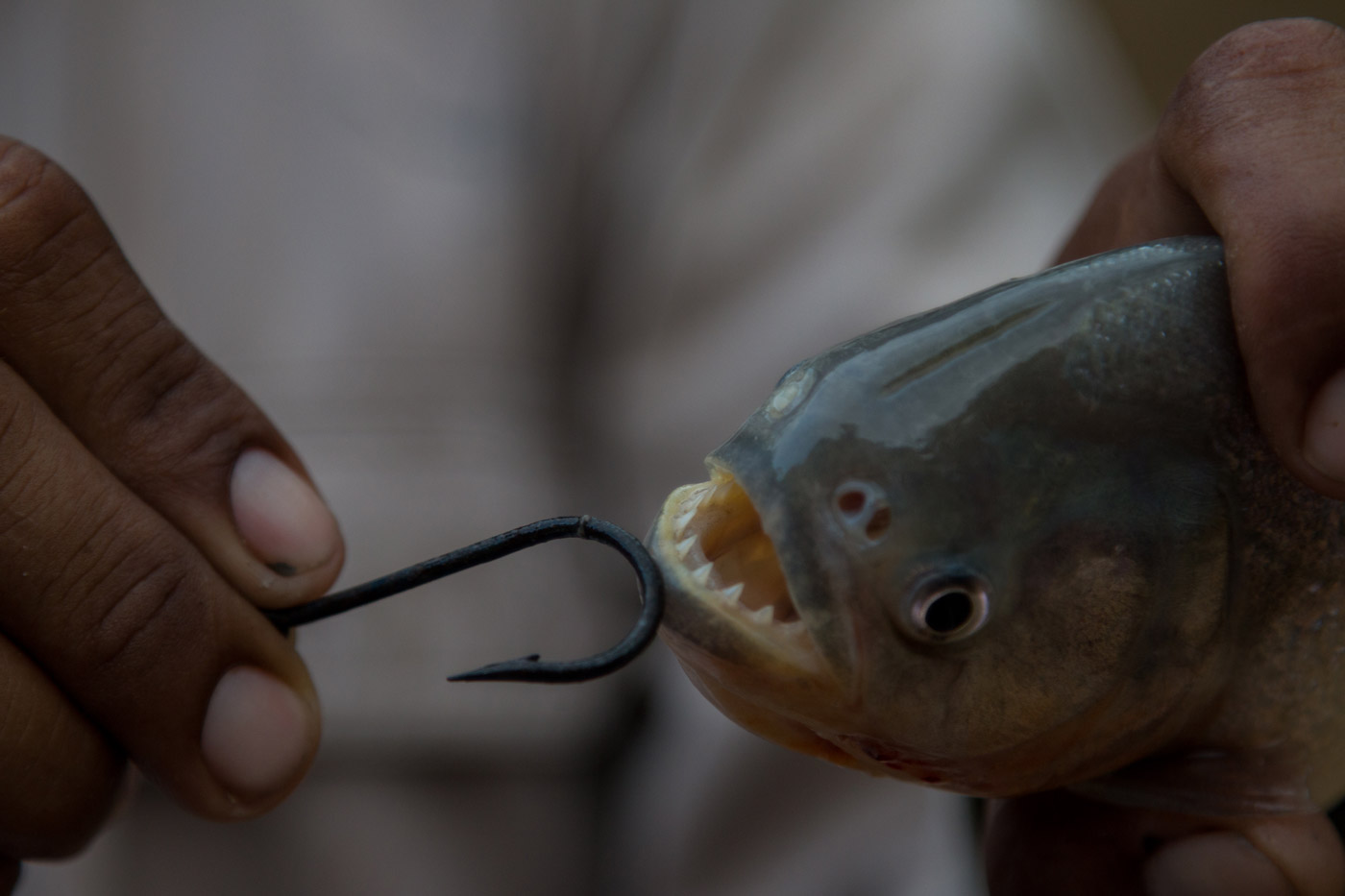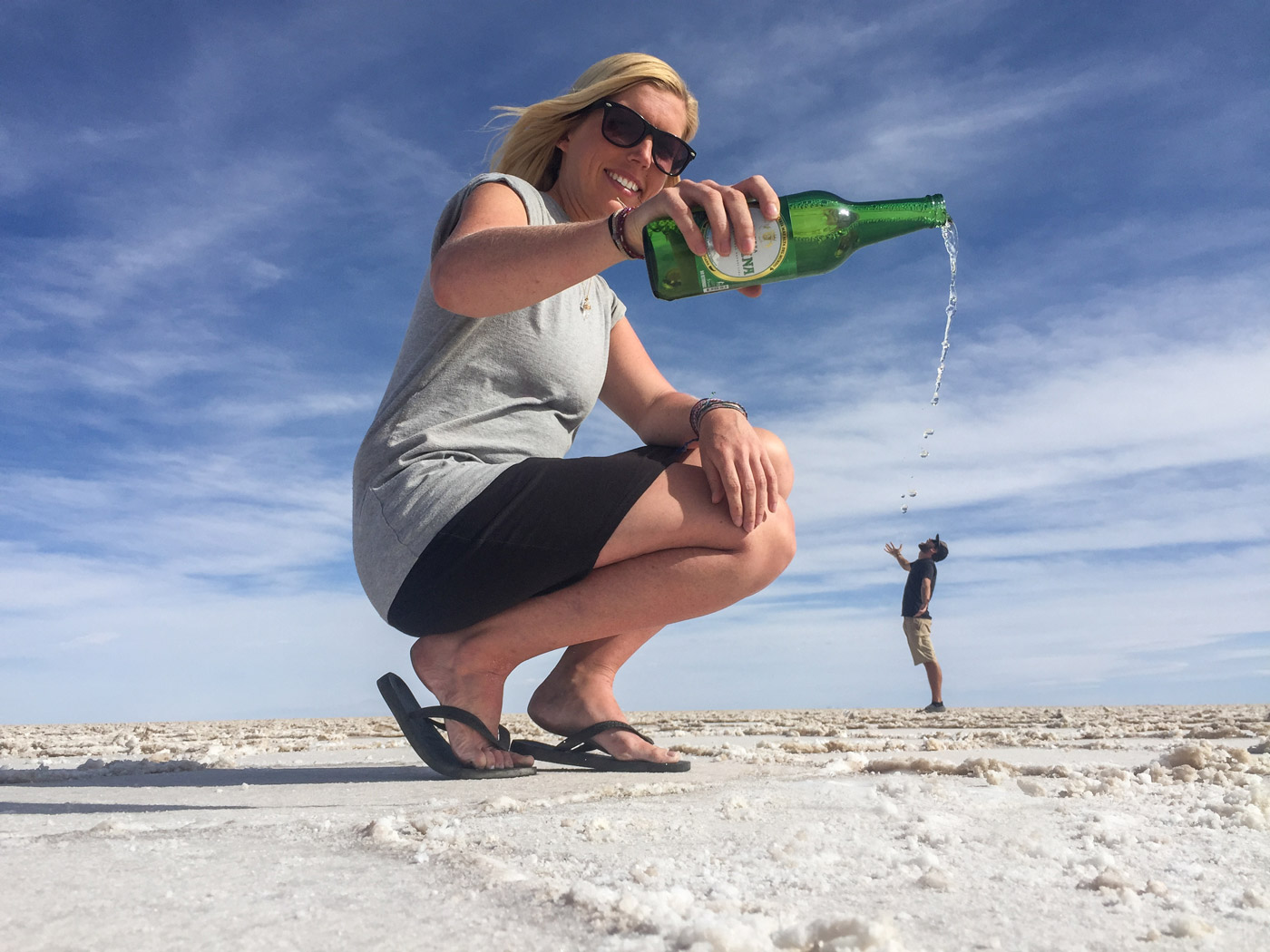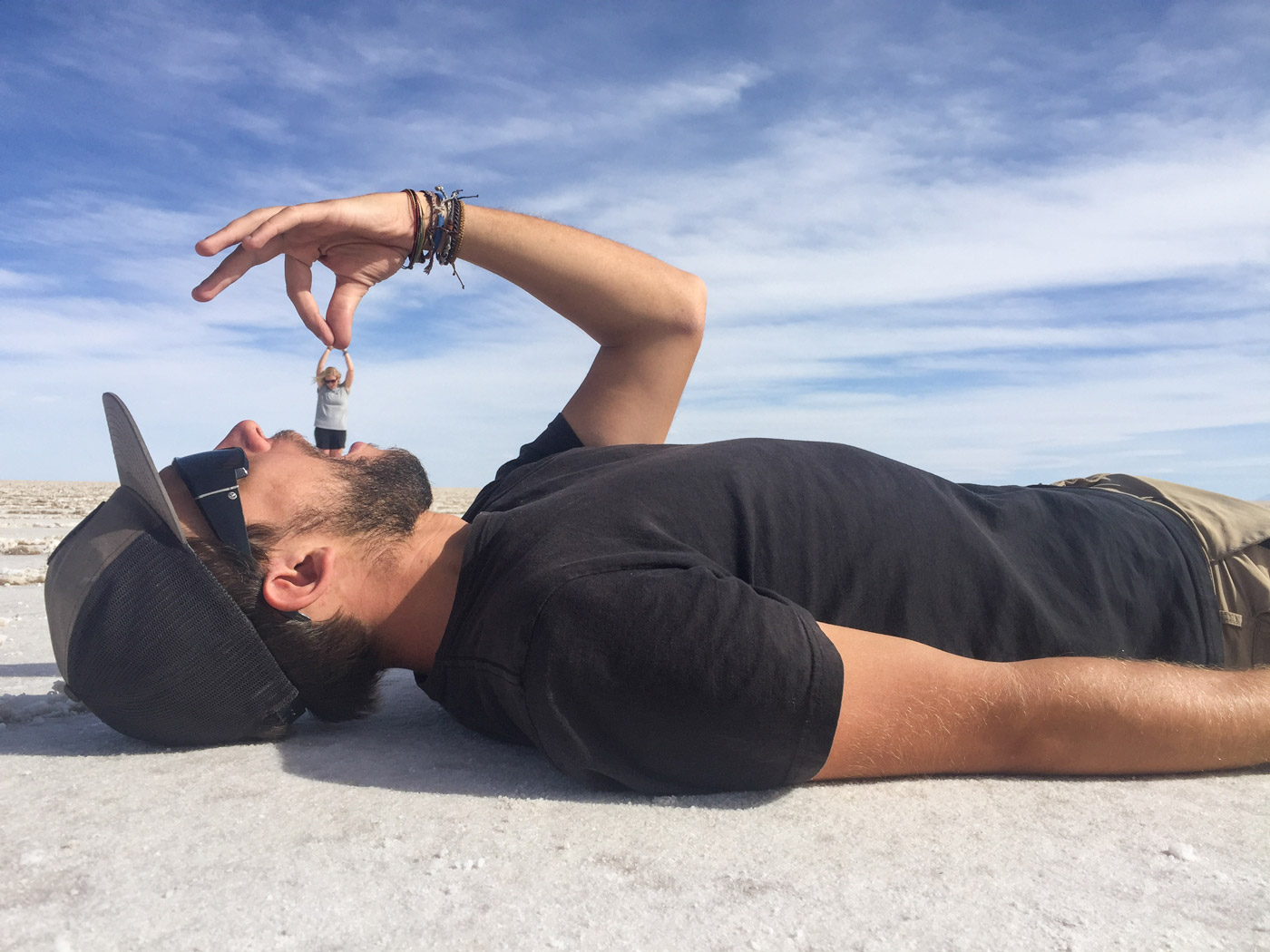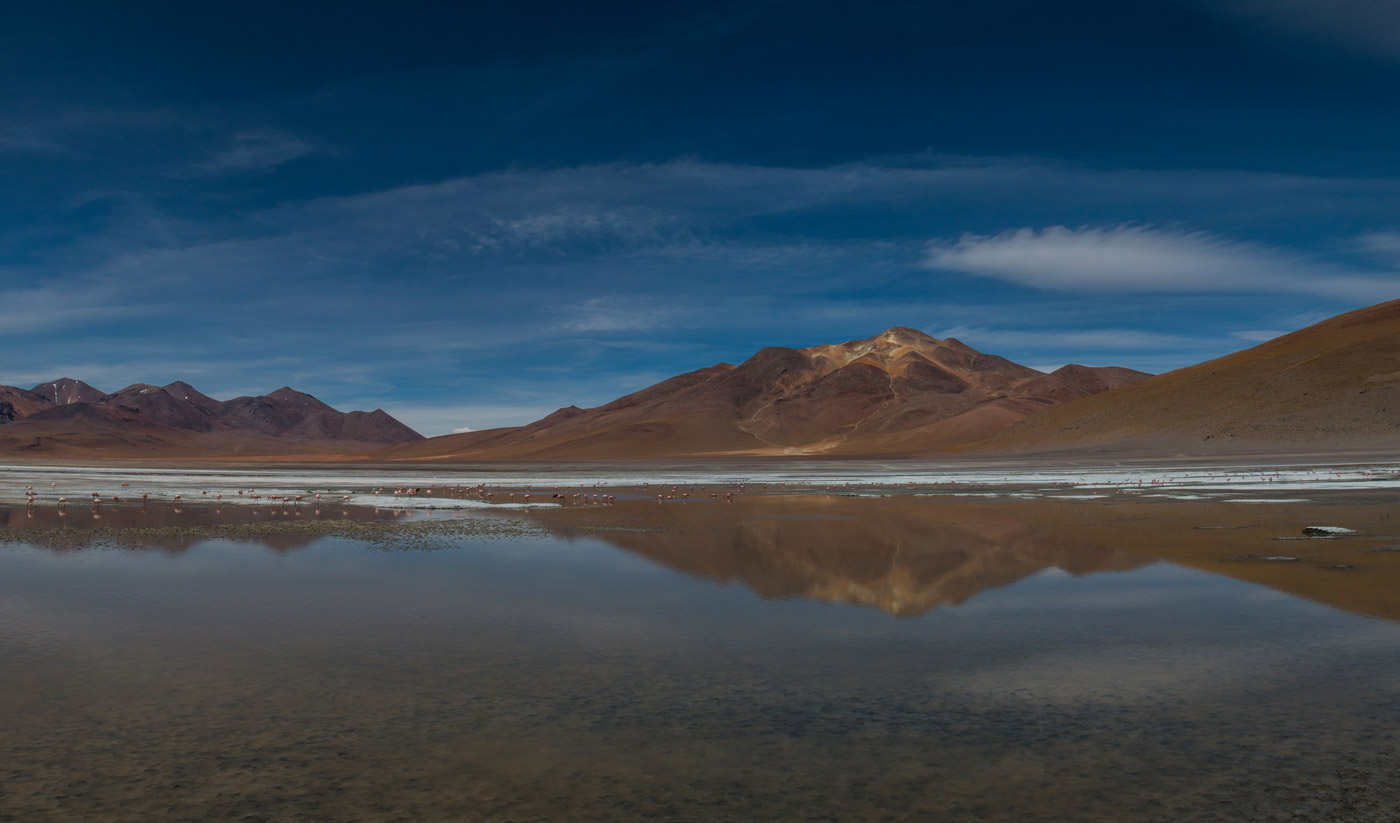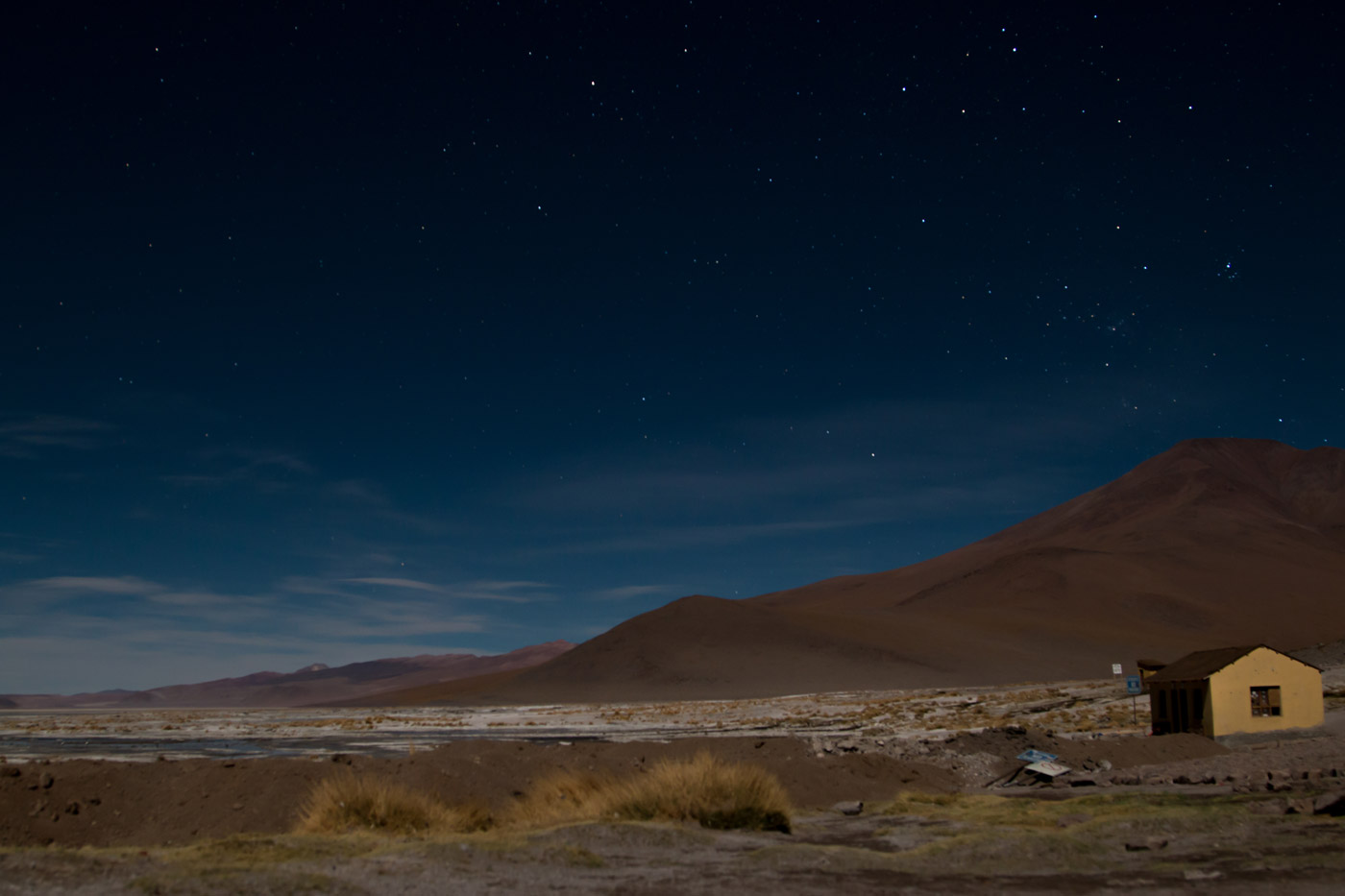Crossing from Peru into Bolivia was uneventful with the border taking a matter of minutes to get our exit and entry stamps and we were on our way without as much as a question, let alone a bag search. Now on the other side of Lake Titicaca, our first stop was Copacabana, a small lakefront town catering mostly to tourists and the usual hippies that stopped in and never left.
Bolivia is the poorest country in South America and is one of only two landlocked countries in the whole of the Americas, partly thanks to losing access to the Pacific coast to Chile in the War of the Pacific. The country has a great variety of terrain and climates from high Andean mountain ranges through to low jungle and in just over three weeks we covered much of this.
On our first afternoon in Copacabana we climbed the mountain lookout overlooking the town and lake to watch the sunset. Not looking at a map beforehand we set out towards the mountain at the base of the lookout and couldn’t find the path to the top. With daylight dying we took the hard way and literally climbed straight up, heading towards the people we could see already perched at the top. We reached the top hot and sweaty but had made it in time for sunset and were rewarded with a great view over the lake looking back towards Peru.
The following morning we took a day trip out to Isla del Sol, a large island in the southern part of Lake Titicaca free of cars and even roads. The boat landed on the north part of the island and we opted to walk from there to the south, a near three hours through amazing landscapes reaching heights of 4100m and giving us panoramic views over the clear, blue water and the snowy mountains of the Andes in the distance. By mid afternoon it was time to take a boat back to the mainland and grab some quick food before jumping on a bus that evening to La Paz.
The bus was a wild ride, spending more time overtaking and beeping other cars than staying in our own lane. Whatever race we were in I was convinced we were winning and on multiple occasions just as we would fall sleep the bus would hit a bump so hard that our bodies left the seat. Already cheating death, at around 10pm we arrived at the waters edge of Tiquina Strait, a passage separating us from the rest of Bolivia. Any other country would just build a bridge across the 800m span but frugal Bolivia instead decided they would just drive large buses down off the road and with the help of pieces of wood as ramps drive them onto floating metal barges just big enough to fit one bus. We disembarked and paid our “ferry” fee before being escorted onto a smaller passenger boat. Together our boat and our bus made their way across the cold, rough water in complete darkness without any lights on whilst other boats, buses and trucks doing the same passed us in both directions. We laughed that it was all part of the adventure and reassured ourselves that as we could see the land on either side we could make the swim if it came to that.
La Paz
Getting off the bus in La Paz we were unfortunately not in the clear yet as we hailed the closest taxi to take us to our hostel. The driver took us to what turned out to be the old location of the hostel and after assuring us this was the one, drove off. We walked up and down the dark, empty street at midnight knocking on random doors and windows hoping to get inside. Unsure what to do and with near empty phone battery we were saved by a taxi driver that stopped and tried to explain to us that we were in the wrong place in Spanish. After paying the taxi fare again we made it to the right place tired and keen to get into the room after the long day.
La Paz is the world’s highest administrative capital, sitting at 3,650m above sea level. The sprawling city sits in a bowl surrounded by high mountains and has grown to extend up and over the hills. Towering over the city, and in a direct line of site from our hostel bar, was Illimani mountain reaching a height of 6,438m and covered in snow year round. We had little trouble with the altitude having already been at elevation throughout Peru and Ecuador but definitely noticed the temperature drop of a night.
As planned, the following day was November 2nd, or Day of the Dead, a tradition throughout Latin America that sees gatherings of family and friends pray for and remember loved ones who have died. Far from morbid or sad, the day is spent celebrating their life and enjoying feasts of the favourite foods the person enjoyed along with music, flowers and offerings such as cake, popcorn, and lollies. We rode the Teleférico (cable car) up and over the busy cemetery for a better view of the city before coming back down and taking a walk through the cemetery grounds. Thousands of people filled the cemetery and surrounds paying their respects to the dead.
La Paz is like one big street market, so much so that we never found a supermarket when we were there. Locals buy everything on the street from the usual fruit and vegetables to beds, clothes, electronics and car parts. Each block on the chaotic streets specialises in a different type of goods making it convenient if you are going shopping for hammers in the hardware block, brooms in the cleaning block or toothpaste with the toiletries but sure to be a good workout if you are trying to do your grocery shopping with the city full of hills and the market stretching 100’s of blocks in each direction for around 8km. As always, our favourite part of the markets was the food and we tried everything we could starting with a 5 boliviano ($1 AUD) choripan each (chorizo on a roll with onion and sauces). We followed this up with chocolate coated strawberries, a passionfruit sorbet and finally an odd but enjoyable beer spider consisting of a large glass filled with beer, beaten egg white and thick cream.
Joining a walking tour we were guided around the city, the fruit markets and through government square where we gained some insight into the history and complicated past of Bolvia. The guide led us through the strange witch markets, visited by those suffering an ailment, searching for wealth or looking to exact revenge on a ex-lover. It offers a variety of potions, medicinal plants, spells and spiritual advice along with having many llama fetuses hanging up for sale. The fetuses are often purchased and buried in the foundations of a new building as an offering to Pachamama (Mother Earth) for protection, health, happiness and good luck.
Having both several years ago read the book Marching Powder about the infamous San Pedro Prison in La Paz we were shocked, yet strangely excited, to be finally seeing it in person. Written by Rusty Young, an Australian backpacker turned author, it details the unbelievable yet fascinating story of an English drug smuggler who ran illegal tours for tourists whilst imprisoned in the jail and his struggle to survive in a prison ripe with violence and corruption. San Pedro is not your average prison, located in a prime location in the middle of the city, inmates are expected to buy their cells from real estate agents. The prisoners run shops and restaurants inside the prison in order to make money and women and children live inside with imprisoned family members. Richer inmates live in luxury apartments and the poor are lucky to survive at all. By day, children run and play and at night cocaine laboratories are setup all within the prison walls.
We walked around the perimeter of the prison before stopping across the street from the front entrance to attempt to get a glimpse of the inside. We watched as young kids and mothers left through the gates, free to leave as they please. After taking a few photos the guards were quickly onto us and with it obvious they were not happy we decided not to push it. With the cameras put away we crossed the street and stood in front of the gate within metres of the prisoners looking out at us before walking away in disbelief happy knowing that we were on this side of the walls.
Not far out of La Paz is the infamous “Death Road”, also known as the World’s Most Dangerous Road. At its busiest it was estimated 200-300 people died on the road each year, though in recent years a safer alternative route has diverted much of the traffic. With a sheer drop of up to 400m in parts and no railings to stop you, the narrow dirt and gravel road leaves little chance for survival in the event of an accident over the edge. Unlike in the rest of the country, the side of the road changes to the left for this stretch of road so that the drivers can look out their window and make sure their cliff-side wheels are still touching solid ground as they inch their way around other vehicles coming in the opposite direction. The road has featured on many documentaries including the Top Gear: Bolivia Special.
We signed up for a tour and, much to our parent’s dismay, spent the day riding down this crumbling “road”, dodging fallen rocks, puddles and potholes 64km alongside the intimidating edge and tried our best to concentrate on looking forward rather than down. We had chosen the aptly named Gravity, the most expensive but highly reputable Death Road tour company, reasoning that it was worth spending the extra money when safety was involved. The downhill mountain bikes we were given were practically brand new 2014-15 models and our guides were experienced and thorough in their safety briefing. One of the guides was very reassuring and stated:
We carry 50m of rescue rope and if you fall any further than that we figure there is no rush to get you back up...
Seeing rusty wreckages way down at the base of the cliffs and homemade wooden crosses along the road were big reality checks and reminded us the seriousness of the situation. Once again on this trip it was one of the times that it is better off telling the parents back home once it was over. We made it to the bottom without incident and after sharing high fives with the group and a relieved hug with each other we celebrated with a well earned beer and some lunch before heading back to La Paz in the mini bus, with the driver opting to take a shortcut by driving back up Death Road…
Amazon jungle
The Amazon basin stretches 7 million square kilometres, covering 40% of the South American continent and including parts of eight South American countries. We had chosen to visit the jungle from Bolivia not only because it is cheaper than in other countries but because it seemed like safety came second to adventure and the activities on offer in the tours were far more “hands on” and exciting. Opting for the more expensive 45 minute flight to Rurrenabaque over the ~20+ hour bus along cliff top roads, we figured we should stay longer to justify the costs and signed up for both a 3-day Jungle tour and a 3-day Pampas tour.
With the Jungle tour up first, our small group of three climbed into a long, skinny boat and headed up the Beni river to camp. We were first shown around the eco-lodge but with the help of the guide’s persuasion decided to spend the first night deep in the jungle instead and loaded up our bags with everything we would need from sleeping bags and tarps to food and water. This tour was to be more about the jungle itself with emphasis on its many plants and insects, and learning how these have been used by locals for not just food but both medicinal and survival purposes.
On the walk to our overnight camp spot we stopped many times for a rest and to learn about our surroundings. Firstly we tasted live termites (minty in flavour and a good source of protein) and then further along chopped a vine out of a tree and drank the fresh water trapped inside. Continuing on we smelt the root of plant used to help headaches, and found a big vine hanging from tall trees and stopped to all have a swing.
Arriving at a clearing we began to set up camp, laying out a tarp to cover the ground before pulling another up over some sticks for a roof. After tying up mosquito nets to cover our sleeping bags the camp was complete and we set off to collect firewood for without fire there would be no dinner. Sweaty from chopping wood with a machete in the hot and humid jungle we walked down to the river to cool off with a swim while watching the sunset. Dinner was impressive considering it was cooked in the dark and on a fireplace. We sat chatting with our two guides in the best Spanish we could muster and when it was time for bed we got into our mosquito nets and fell asleep to the sounds of the jungle all around us.
Waking up to the same sounds, we had breakfast and set off walking through the dense, humid jungle with our guide, Miguel, up in front recklessly chopping us a path with his machete. We stopped to try some wild garlic and then to eat live worms for a snack and were surprised when they tasted like coconut. Finding a rubber tree, Miguel stuck leaves to Lauren’s ears as earrings and we all had a go at crushing some leaves in our palms and watching it eventually turn purple. Mixed with water, this is used as both a dye for material as well as a natural insect repellent and so we took turns painting each others faces and arms. Miguel decided to dip Lauren’s fringe in the dye, turning her once bright blonde hair colour into a dark purple. According to him it would wash right out but later that afternoon when she tried unsuccessfully, he changed his answer to a couple of days and she was not very impressed. Today, over a month since leaving the jungle Lauren hilariously still has a purple fringe!
After resting back in the town of Rurrenabaque for a night, the next morning we took off in 4WDs to begin the 3hr trip to meet our boat on the shore of the river. We piled aboard and set off for our 3 day Pampas tour boating up through the Amazon. Expecting to see more animals in this tour we were not disappointed and after rounding the first corner our guide already had us face to face with a caiman (alligator) laying on the shore. Over the next few hours in the boat there were so many animals you practically had to stop looking at one to look at another. Over the course of three days we saw families of capybaras, hundreds of caimans, monkeys (squirrel and howler), turtles, piranhas, pink dolphins, kingfishers, herons and finally after months of trying, toucans!!
The mosquitoes, especially at dusk, were huge and overwhelming. They were so persistent that they would bite through our clothes and when there was enough of them together repellent did little to keep them at bay. We were told by our guide that both malaria and dengue fever were rare in these parts, however after counting over 50 bites on my body at one time I was sure that if there were any chance then I had definitely increased my odds.
Despite normally enjoying the heat, the temperatures and humidity in the jungle were unbearable. There was little relief from the heat day or night with the only comfortable time being standing under a cold shower and even then as soon as you stopped to dry off you would start sweating.
With plans to get up to watch the sunrise we were awoken very early anyway by the loud, creepy roar of the howler monkeys in the trees surrounding the lodge. After a quick ride down the river we climbed the bank just in time to watch the sun appear over the flat plains of long grass.
In what was just one of the many wild activities that drew us to visiting the Amazon in Bolivia, we got into long gumboots and went anaconda hunting through the long grass. Knowing that they could be lying in the grass and shallow mud, we carefully took each step on the lookout for any sign of a snake. Our guide was carrying a very hi-tech snake catching device, a stick with a forked branch on the end, and after around half an hour of us all searching he called out “Snake!” and we came running. He had managed to spot, and aggravate, a cobra and by the time we got there it was already attempting to strike him. As we all attempted to quickly take photos it took off for the head high grass with our guide in pursuit. He “thankfully” managed to grab it by the tail as it buried itself in the long grass and then pulled the grass aside so that we could take another look. Unfortunately there were no anacondas to be found but we did get to see another much bigger cobra and the remains of a baby anaconda that had been eaten by a vulture.
That afternoon we took the boat up the river and went piranha fishing, using pieces of raw steak for bait. Our guide was unsurprisingly the most successful and it was great to finally see a piranha up close with its razor sharp teeth.
Another strange yet interesting animal in this part of the jungle was the pink dolphins. We were lucky to spot them daily, swimming in packs beside the boat and surfacing briefly for air. On the last day we had the opportunity to go swimming with them, jumping over the side of the boat and into the murky, brown water not far from where we had been piranha fishing the day before. Our guide reassured us that the caiman do not like getting close to the dolphins which was a relief to hear when we could see them on the shore from where we were swimming. I also anxiously asked if the horrific sounding penis fish inhabited these parts. Thankfully the guide, who suspiciously did not go swimming, said no. The water was cool and refreshing from the unrelenting heat and whilst it was unsettling to not be able to see what was below the surface the majority of the group were brave enough to get in.
After a long trip back to Rurrenabaque we waited at the airport for our tiny plane and flew back to La Paz. We got off the plane and straight onto the tarmac into welcomed cooler weather and having spent a week at only 270m elevation in the jungle the sudden jump to the altitude difference of La Paz took a few days to get back used to.
Sucre
Despite La Paz having more government departments, Sucre is actually the constitutional capital city of Bolivia. After a dreadful overnight bus to Sucre, we quickly discovered that the quality of buses in Bolivia falls very short of those we experienced in Peru.
After reading an advertisement online, we took the opportunity to visit a local childcare and “volunteer” for a few hours, which basically involved playing and stirring up the crazy little kids. On arrival we were greeted by the enthusiastic classroom who came running all at once to hug us. The place was closer to a zoo with kids running around and throwing things everywhere. One boy carried a car tyre to the top of the playground stairs and when the carer was distracted by the tyre tumbling down three other little boys escaped and ran off down the road. The only reason it was realised they were missing was because I thought I better tell one of the ladies in the kitchen. One other boy was crying after hitting his head on the ground after a fight and so the carer walked over and covered him with a blanket hoping the problem would go away. All was not lost, and while the younger ones were having a nap Lauren and I sat with one of the older boys, Markel, and helped him with an alphabet puzzle before moving to the table to draw together. He was so happy to be drawing with us and kept asking us to add things like mountains, flowers, volcanoes, and his house. When it was time to leave he excitedly accepted our drawings as a gift and came with the carer to wave us goodbye at the bus stop.
It was recently discovered that Sucre is home to one of the largest collection of dinosaur footprints, located just out of town in a mining quarry. I was a little sceptical at first but we both went out to investigate and found a dinosaur information centre established next to the footprints offering more of an explanation. Together with a guide we walked down the hill and into the quarry to get a close up look of the 5000+ footprints left by many different dinosaurs long ago. Millions of years later shifting tectonic plates have since driven the ground upwards leaving what was once a flat clay beach to now be a 1.2km limestone cliff displaying the footprints for all to see.
Uyuni Salt Flats
The bus to Uyuni took much longer than expected and without having packed much food, plus a breakdown in the hot sun for an hour, it felt like even longer. We got talking to a couple in front of us on the bus, Liam and Fran from England. We started a super competitive Simpsons game that Liam and I ended up relentlessly continuing on for the next four days, much to the amazement/annoyance of everyone else in our car. At last count we one for one named over 70 unique male characters between us.
After finding a hostel together we walked between agencies to find a Salt Flat tour leaving the following day. The four of us settled on Red Planet, an agency more expensive than most but highly recommended from people we had met previously. It also was one of the only companies with English speaking guides and the only company that visited the hot springs during the night rather than in the morning with all the other groups. We had heard several horror stories about other companies and were also keen to have an experienced guide help take the funny perspective photos (see below).
The Bolivian salt flat, Salar de Uyuni, is the world’s largest salt flat at 10,582 square kilometres. It is so flat that the variation in surface elevation over the entire area is less than one metre and as a result it is used by NASA to calibrate satellites from space.
The tour started the next morning firstly with a stop in the train cemetery, a site of abandoned trains left behind after the mining industry collapsed. Our car of six plus our driver met up with the other car from Red Planet and we were given some historical background before walking around the abandoned yard climbing on the rusting carriages and taking photos of the unusual sight. Nearby was a local salt factory, where we were given a demonstration on how local families retrieve salt from the salar and prepare it for sale as table salt. With a quick stop for photos at the Dakar sign, erected to commemorate the world famous rally that takes place across the salt flat, we were on our way across the salt flat.
Taking the perspective photos were a lot of fun, albeit harder than expected. We teamed up with Liam and Fran and took turns laying on the salty ground with a camera giving directions as the opposite couple were positioned spaced apart out in front giving the illusion of one being much bigger than the other. Our guide thankfully helped us with the more complicated shots involving some of the props we had with us.
Just before sunset we stopped at the bizarre looking fish island sitting out of place in the middle of the salt flat covered in cacti. The cactus has adapted to flourish on the island in the middle of a salt wasteland where no other life, animal or plant, can survive.
That night we stayed in a salt hotel, where everything in the room including the walls, floor, table, chairs and even the bed frame were made of salt, extracted as salt blocks cut from the salar. I take no shame in admitting I couldn’t resist the urge and ended up tasting both the wall and a piece off the ground. I was sure to lick high up the wall where most normal sized people would not be able to reach…
By the second day we were off the salt flat and driving through the remote Bolivian desert. We made several stops during the day including a mostly abandoned old town that looked like it was out of an old western movie. Lunch was overlooking llama filled grasslands before we moved on to a lagoon filled with flamingoes, Piedra del Arbol, a red lagoon, and finally some geysers which were ejecting steam and bubbling hot mud into the air.
Our accommodation was in a little building in the middle of the desert, so remote that there was no electricity or even running water. As promised, later that night after dinner we all braved the outside air and went down to the hot springs, beers and wine in hand. To have the whole hot springs to just our company was amazing let alone at night below a star filled sky and full moon. We ended up staying in the naturally heated and very hot water for hours just watching the stars and spotting shooting stars. This alone made the tour choice worthwhile and is a definite highlight for me in the past 11 months of travel. The next morning as we were driving off we watched as 20+ 4WDs all pulled up and everyone else jumped in the water for around half an hour before having to leave.
The final day of the tour saw us continuing through the Salvador Dalí Desert and Laguna de Verde before arriving at the Bolivian border and saying our goodbyes to some of our group and our guides. We crossed out of Bolivia and into the next country of our journey, Chile, where we took a quick 45 minute bus ride through immigration and to town to find a hostel in San Pedro de Atacama, the driest desert in the world.
